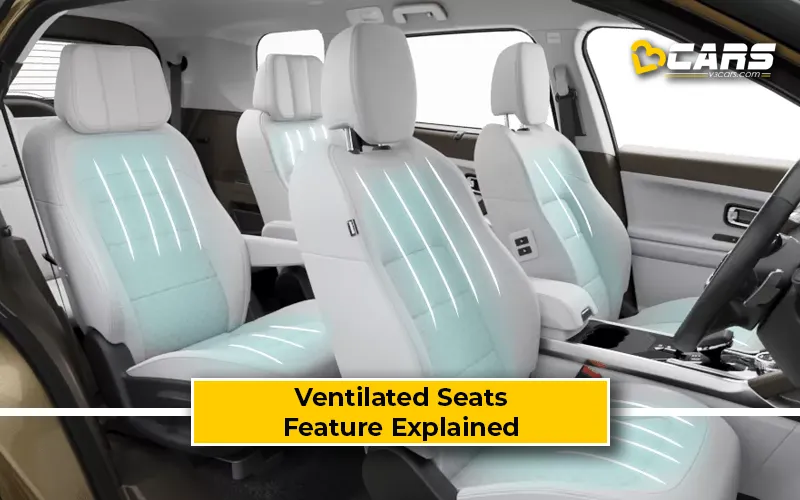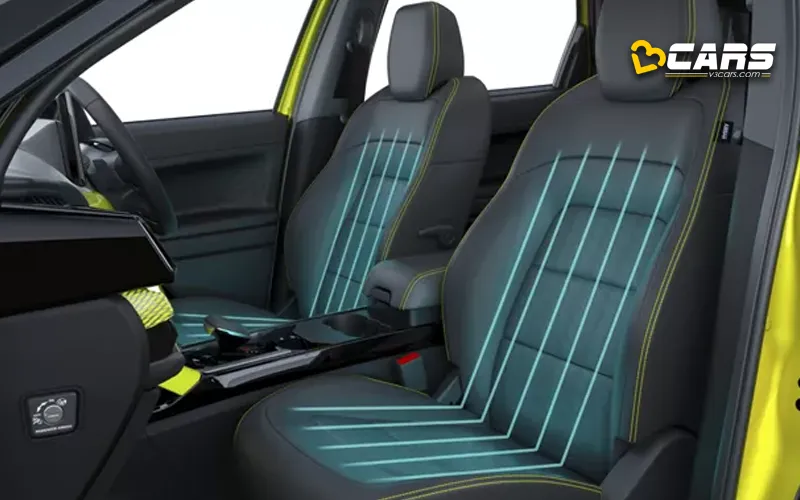Ventilated Seats - Feature, Pros & Cons, Working Explained
Ever get that sticky, uncomfortable feeling after a long drive, especially in the scorching Indian summer? Enter ventilated seats, your personal oasis on wheels. This feature explained article delves into everything you need to know about this comfort-enhancing feature, helping you decide if it’s worth adding to your driving experience.

We have also included a list of affordable cars in India with ventilated seats to help you make informed purchasing decisions.
What Are Ventilated Seats In A Car?
Ventilated seats are a luxury feature that channels air through the seat cushions, keeping the driver and passengers cool and comfortable. This feature is particularly beneficial during the scorching summer months, as it helps to reduce heat buildup and prevent discomfort, leading to a more enjoyable and less stressful driving experience.
How Do Ventilated Seats Work?
Ventilated seats use a system of fans and perforated upholstery to circulate cool air, keeping you comfortable and fresh, especially on hot and humid days. It’s worth mentioning that ventilated seats are different from cooled seats. Unlike cooled seats, ventilated seats do not feature cooled coils. Hence, it does not blow cool air.
Some ventilated seats, like the ones found in the Maruti Nexa XL6, Toyota Fortuner and most Hyundais, suck air into the seat and create an evaporative effect that cools the body. Others use fans to blow air directly to the occupant. Cooled seats, on the other hand, blow refrigerated air from the car’s air conditioning system or from cooling elements built into the seats. Cooled seats are typically found in more upmarket cars.
How To Activate Ventilated Seats?
Here are the steps required to activate ventilated seats in a car:
1. Locate the controls: Look for buttons or switches on your dashboard or near the seats. Depending on the car model, the control for the ventilated seat could be on the centre console, door pad, or the base or side of the seat frame. Consult your car’s owner’s manual to locate the button.
2. Power Up the Fans: Press the appropriate button or switch to turn on the ventilation system. Most systems offer multiple fan speeds, allowing you to adjust the airflow intensity to your preference.
3. Find Your Comfort Zone: Experiment with the different fan speeds and settings to find what feels most comfortable for you. Some systems might also have additional features like individual adjustments for the backrest and bottom cushion.
4. Enjoy the chill: Sit back and relax as the cool air circulates through the seat, keeping you comfortable and refreshed on your journey.
What Are The Pros And Cons Of Ventilated Seats?
The pros or advantages of ventilated seats are:
- Say goodbye to sweaty backs: Ventilated seats circulate cool air through perforated seat cushions, keeping you pleasantly chilled even on sweltering days.
- Enhances comfort: Ventilated seats can ease back pain and muscle tension, as the airflow improves circulation and prevents pressure build-up. This benefit is especially valuable for long journeys.
- Improved resale value: Ventilated seats add a touch of luxury to your car, enhancing the overall driving experience and perceived value.
The cons or disadvantages of ventilated seats are:
- Cost conundrum: Ventilated seats often come at a premium price, increasing the initial cost of the car or requiring an expensive aftermarket installation.
- Maintenance: Like any mechanical system, ventilated seats require occasional maintenance and repairs, which can add up over time.
- Noise: Some ventilation systems can generate noticeable fan noise, particularly at higher settings. This might not be ideal for noise-sensitive passengers.
- Not for everyone: While most people enjoy the cooling effect, individuals with certain medical conditions, such as this author who has rods in his spine, might find the constant airflow uncomfortable.
How Expensive Is It To Repair Or Replace Ventilated Seats?
The cost of repairing or replacing ventilated seats can vary widely depending on several factors, including:
- Minor issues: A faulty switch or a clogged seat cushion might only require a simple repair costing around Rs. 1,500 to Rs. 5,000.
- Major malfunctions: A broken fan, damaged control module, or faulty wiring could lead to more extensive repairs, such as replacing the entire seat, which could cost upwards of Rs. 20,000.
- Car make and model: Different cars have different ventilated seat systems and parts, with some being more expensive than others. Luxury brands typically have pricier repair costs compared to budget cars.
- Labour costs: The location and rates of the repair shop you choose will affect the labour cost involved. Expect higher fees in urban areas compared to rural locations.
- Warranty coverage: Check your car's warranty to see if the ventilated seats are covered for repairs or replacements. This could significantly reduce your costs.
- Original vs. aftermarket parts: Generally, original parts are more expensive than aftermarket options, but they may also be of higher quality and offer better compatibility.
Here are some tips for minimising the cost:
- Get a diagnosis: Before committing to any repairs, have a qualified mechanic diagnose the problem to determine the exact cause and the associated cost.
- Shop around: Compare prices from different repair shops to find the best deal.
- Consider aftermarket parts: For minor repairs, using high-quality aftermarket parts can be a more affordable option.
- Check your warranty: Some car warranties may cover ventilated seat repairs or replacements.
Replacing the entire seat assembly is usually the most expensive option and can potentially cost you thousands of rupees. It's generally only considered as a last resort if the repairs are deemed too expensive or impractical.
Is It Possible To Install Ventilated Seats After Buying A Car?
Yes, there are aftermarket options available, such as ventilated car seat covers. In India, Riggear, a company based in Bengaluru, offers a single ventilated seat cover that fits all car seats at a cost of Rs. 8,000. However, in our opinion, it is a high price to pay for just one seat.
How Easy Or Complex Is It To Install Aftermarket Ventilated Seats?
In the case of Riggear’s ventilated seat covers, it is as easy as placing the seat cover over the seat and connecting the power cable to the car’s 12V socket. However, it is important to note that aftermarket seat covers affect the following factors:
- Not aesthetically pleasing: Having an aftermarket seat cover over the OEM seats may not be aesthetically pleasing for all. However, if you MUST need this feature, then go for it by all means, provided you find value in these aftermarket products.
- Alters driving position: Aftermarket ventilated seat covers are generally thick and hence, they alter the driving position as you sit a couple of inches higher and a bit more forward.
- Not as effective as OEM ventilated seats: Aftermarket seat covers typically blow out air that may be sufficient for most users. However, most aftermarket seat covers lack cooling coils found in premium cars. In our experience, ventilated seats that suck in air, like the ones found in the Maruti Nexa XL6 or the Toyota Fortuner work better
What Are Some Affordable Cars In India With Ventilated Seats?
Here are the cars and their variants priced under Rs. 20.0 lakh that offer ventilated seats in India:
- Tata Nexon
- Kia Sonet
- Kia Seltos
- Maruti Suzuki XL6
- Hyundai Verna
- Hyundai Creta
- Skoda Slavia
- Skoda Kushaq
Note: Check your car’s fuel cost with Fuel Cost Calculator in India
Verdict - Should I Get Ventilated Seats From The Aftermarket?
Your options for an aftermarket ventilated seats are quite limited in India. Apart from Riggear’s aftermarket ventilated seats, which are quite expensive, we could not find any other option in the aftermarket. When we contacted car accessories shops, they recommended going for wooden bead seat covers. However, we do not find them aesthetically pleasing. If you are looking for an affordable car with ventilated seats, check the list above and buy a variant that offers ventilated seats.
If your car does not come with ventilated seats and your back gets sticky and uncomfortable during long drives, the easiest way to ensure a cool back is to avoid leather or leatherette seats. Fabric seats are softer than leather and are more effective in absorbing sweat and keeping your back cool. They also stay cool in the summer and warm in winter, which is helpful in our weather conditions.
Note: Check your Car EMI with our - Car Loan EMI Calculator




0 Comments